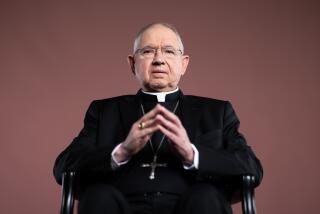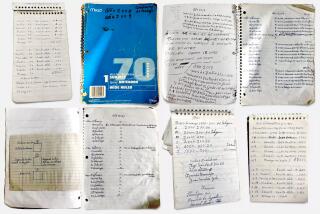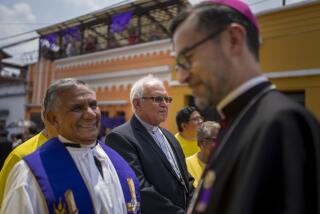‘Juan Diego Was Noble, Sweet’
MEXICO CITY — Salvador Suarez, a 37-year-old shoe salesman, traveled all night on a bus from his village in western Mexico and entered the Basilica of Guadalupe at 6 a.m. Wednesday--four hours before the religious experience of his lifetime.
Suarez is a full-blooded Nahua Indian and devout Roman Catholic. This was the day his spiritual godfather, Juan Diego Cuauhtlatoatzin, would become the church’s first indigenous American saint.
The church makes saints of the dead to hold up as models for the living. As other worshipers filled the vast basilica with songs and chants, awaiting the arrival of Pope John Paul II, the shoe merchant from Tuxpan reflected on the character of the 16th century Chichimeca Indian and on a phrase heard at home as a child: “May God make you like Juan Diego.”
Across the Western Hemisphere, Catholics watching the pope on television heard the legend of Juan Diego and the Virgin of Guadalupe. She was the dark-skinned mother of Jesus who appeared from heaven and asked for a church to be built for her people. He was her chosen messenger, the humble Indian on whose cloak she miraculously imprinted her image to persuade a skeptical Spanish bishop.
The story helped Spanish colonizers win Indian converts to Catholicism across the Americas, but it was Our Lady of Guadalupe, not Juan Diego, who became Mexico’s patron saint. Until now, he has knelt in the Virgin’s shadow, an actor in a supporting role--evidence to many that a Eurocentric church slights its Indian faithful.
Wednesday was Juan Diego’s day.
“We have always thought of our indigenous brother as a saint; it has taken the Church of Rome 500 years to catch up,” Suarez said, seated in a section with 34 Nahua neighbors in loose-fitting white suits. “But that does not make us any less content. It’s something marvelous.”
Suarez said he follows Juan Diego’s example by doing volunteer work in his impoverished village.
During a recent storm, an elderly neighbor slipped on the mud floor of her cardboard shack and broke a foot. Suarez spent four hours trying to get her admitted to a series of nonindigenous medical clinics, which turned her away. Finally he delivered her to an Indian-run clinic in nearby Guadalajara.
“Juan Diego was noble, sweet and charitable,” Suarez said. “He would have done the same.”
Will his sainthood help raise Mexico’s 10 million Indians from poverty and racial discrimination by the mestizo majority?
“Nothing is going to change unless we change it,” Suarez said. “His sainthood will help us reflect more on good examples to follow. Leaders will emerge, and we will lift ourselves.”
Millions of worshipers have flocked to Mexico City for the pope’s visit, not all of them so familiar with St. Juan Diego.
According to a survey by the newspaper Reforma, 83% of Mexican Catholics believe that Juan Diego was a real person, despite the doubts of some scholars. But nearly as many said they had never prayed to him.
“For all our lives we have seen Juan Diego kneeling in front of the Virgin, so people are reluctant to think of him on his own,” said Felipe Avila, who sells religious statuettes outside the basilica. “Maybe after the pope has gone, interest in him will pick up.”
Catalina Castro Cruz, 37, said the Virgin of Guadalupe appeared on her family’s ranch in Veracruz a few years ago and helped cure her sister-in-law of cancer, prompting the family to build a little chapel there in the heavenly lady’s honor.
“I have never asked Juan Diego for a miracle,” Castro said. “But if he is--as it is said--the one the Virgin chose to speak to, then he is beautiful to me.”
To canonize Juan Diego, the Vatican had to certify a miracle. It ruled that the recovery of a young Mexico City man from massive head and spinal injuries in a three-story suicidal plunge was due to his mother’s prayers to the Indian.
If the pope has his way, Juan Diego will soon be busy answering more prayers. In his homily Wednesday, John Paul asked the new saint to bless families, strengthen marriages, help parents give their children a Christian upbringing and ease the plight of the poor, the sick and the lonely.
Reforma reported Tuesday, tongue-in-cheek, that Juan Diego had already performed a few miracles this week: The federal and Mexico City governments, run by rival parties, collaborated on the papal visit; farmers protesting plans for a new airport suspended their protest during the pope’s stay; and streets along the pope’s route were cleaner than ever.
The canonization Mass drew a crowd of 150 from the Archdiocese of Los Angeles, where Juan Diego and the Virgin are well known among Mexican Americans.
Floriza Martinez, 75, a Long Beach entrepreneur, said she prayed to Juan Diego and the Virgin that she could make the trip despite having been diagnosed in May with cancer. She underwent surgery in early June and recovered.
“Juan Diego is a healer,” she concluded before heading to the basilica.
One couple who planned to be with her group, Ruben and Martha Lujan of Alhambra, reported that a miracle had kept them home.
Ruben Lujan, 65, a retired physical rehabilitation counselor, has not been well. His wife said she prayed to Juan Diego for his health. A week ago, he went for his annual physical. He had four clogged arteries and underwent a quadruple bypass Friday.
Had he delayed the exam until after the pilgrimage, he said, “I might not have made it back home.”
More to Read
Sign up for Essential California
The most important California stories and recommendations in your inbox every morning.
You may occasionally receive promotional content from the Los Angeles Times.










